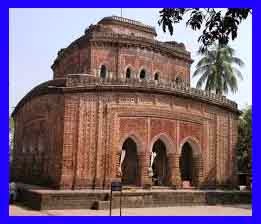The Kantajiur Temple
Contemporary attraction and legends: ubhayabolata
At the end of the Middle Ages kantajiur terakotaya narrate the story of the social life there. It can be taken as an example, in the south east corner of the temple captive down the right side of the story of the life of contemporary society has terracotta
Image: Contemporary society tale of reclusion
It turns out that there is an elite person or persons of his subordinate, or to pretend to be visiting a prominent businessman on an ornate palanquin. Carrying palanquin bearer 6. Palanquin followers are led by men on horseback, the keeper of the peace. Following him, camel riding and walkers. Walkers have a spear in hand. Palanquin a bansibadakake turns down the back of a dog is going to run. In all, drsyati Palanquin quite nice. Sedan left hand lightly on top of the pillow against ascending graphical fashion ayesabhare hookah pipe is tension. Are expressed as a sweet smile on his face and a happy life, hint. The scene, as people tire mogul decorated cloth, suddenly, slacks and shoes. Crown of the head of one of the gods, is emblazoned. Beharadera sword in hand. Think of a man on horseback to carry the torch. It looks as though it is a night scene bhramanacitra.
They are ordinary people who have seen terracotta both women and men. E people of the infantry, guard, protector, boatman, palanquin bearer and has a laborer.
Emkechena terracotta panel of artists, among them the bird, peacock, cock, poultry etc. Livestock and other animals, including rhinos, horses, goats, buffalo, wild pigs, dogs, snakes, camels, elephants, monkeys, big sinyukta deer, common deer, lions and cows.
Kantajiur terracotta temple is a beautiful description of the transport system is also available. Pasucalita transport such as carts, carriages and manasa boat, Sedan, etc. were used at that time. 3 types of boats can be seen in the boat: rod, boat or long-boat, a soldier of the boat or sampan boats and freight boats. Terakotaya can be seen that, when being used for long-range naukaguloke ananda (phalakacitra 23).
Image: aristocrats Boating
Society in general, passengers sitting in rows, with a slightly lower sing or play instruments play faster rod running down the boat form. Army boats carrying weapons of war and are being used (phalakacitra 24).
Image: A European war ships
It is likely that a European war ships. Soldiers carry. However, the men dressed in Mughal. Of boats are available to passengers and goods are carried products. General cart, carriage, Sedan travel and transportation in the country, in general, people seem to be used. They figured they could use that would be very elite, and they were used to draw the hookah pipe.
Kantajiur terracotta temple, it appears that the hunting scenes, prominent members of society, leisure and entertainment, as well as the victims are very welcome. The common people would enjoy it. Hunting scenes, elephants, horses can be seen. The practice of this kind was the period of British rule. (Bangladesh Dinajpur District Gazetteer, 1975) was a common thing in the sinyukta poaching deer, common deer, sinyukta goats, wild boar, and seems to have been a victim. Sastrera weapons used for hunting in the sticks, bows, arrows, swords, spears, the torch was used. Dogs helped people. The elephant's trunk with a lot of deer hunting quarried. No image can be seen dressed in royal hunters on the mogul (phalakacitra 25).
Image: Different views of the victims
There are people dressed in the north Indian temple ceremonies panes. Unexpectedly, pajama-clad people are ceremonies Temple panes. Unexpectedly, pajama-clad men and women dressed by Salwa shirt is very easy to identify. The head of the helmet. The dress and the helmet seems that the district Mughal royal court and nobles were accustomed to wear. The temple body panes European clothing is a little suspicion. The most notable is a picture where a man dressed in European clothes, dressed in Mughal akajana hatite help soldiers recover fairly .46 As can be seen, the fruit motifs inscribed, Members of the eighteenth century and the surrounding area can be found in a transparent jibanalekhya. Note that here, the temple is almost completely different mythology has been inscribed. Images of contemporary life has been so well described. Combination of these two contradictory trends that fall into each ubhayabolatara.
Information Instructions:
4646. Sirajuddin MA. "Kantajiur Temple: terracotta depict contemporary attraction", "Members: History and Tradition", Ahmed S. UK carried out in the history of Bangladesh, Asiatic Civil Military Press, Dhaka, 1996, pp 380



0 comments:
Post a Comment